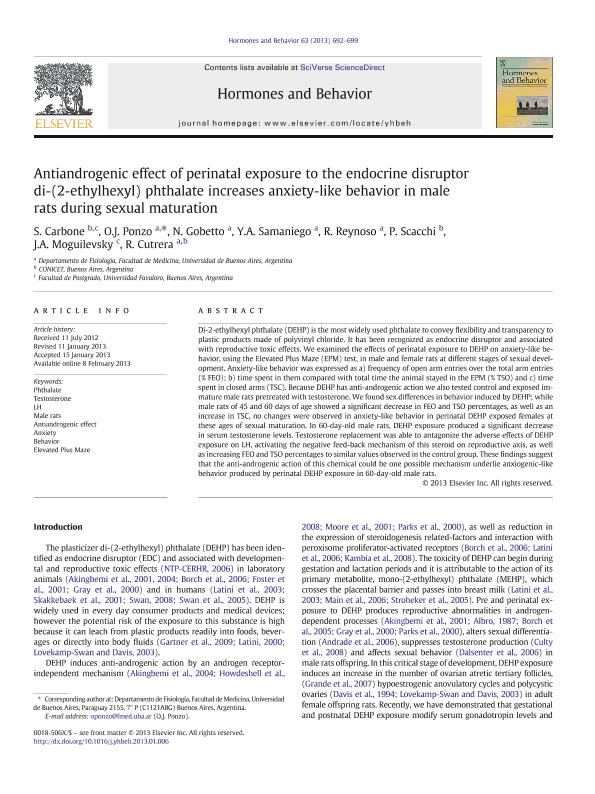Mostrar el registro sencillo del ítem
dc.contributor.author
Carbone, Silvia Elena

dc.contributor.author
Ponzo, Osvaldo Juan
dc.contributor.author
Gobetto, María Natalia

dc.contributor.author
Samaniego, Y. A.
dc.contributor.author
Reynoso, Rita Paola

dc.contributor.author
Scacchi, Pablo

dc.contributor.author
Moguilevsky, Jaime Alberto

dc.contributor.author
Cutrera, Rodolfo Angel

dc.date.available
2017-05-02T19:24:40Z
dc.date.issued
2013-05
dc.identifier.citation
Carbone, Silvia Elena; Ponzo, Osvaldo Juan; Gobetto, María Natalia; Samaniego, Y. A.; Reynoso, Rita Paola; et al.; Antiandrogenic effect of perinatal exposure to the endocrine disruptor di-(2-ethylhexyl) phthalate increases anxiety-like behavior in male rats during sexual maturation; Elsevier Inc; Hormones And Behavior; 63; 5; 5-2013; 692-699
dc.identifier.issn
0018-506X
dc.identifier.uri
http://hdl.handle.net/11336/15888
dc.description.abstract
Di-2-ethylhexyl phthalate (DEHP) is the most widely used phthalate to convey flexibility and transparency to plastic products made of polyvinyl chloride. It has been recognized as endocrine disruptor and associated with reproductive toxic effects. We examined the effects of perinatal exposure to DEHP on anxiety-like behavior, using the Elevated Plus Maze (EPM) test, in male and female rats at different stages of sexual development. Anxiety-like behavior was expressed as a) frequency of open arm entries over the total arm entries (% FEO); b) time spent in them compared with total time the animal stayed in the EPM (% TSO) and c) time spent in closed arms (TSC). Because DEHP has anti-androgenic action we also tested control and exposed immature male rats pretreated with testosterone. We found sex differences in behavior induced by DEHP; while male rats of 45 and 60 days of age showed a significant decrease in FEO and TSO percentages, as well as an increase in TSC, no changes were observed in anxiety-like behavior in perinatal DEHP exposed females at these ages of sexual maturation. In 60-day-old male rats, DEHP exposure produced a significant decrease in serum testosterone levels. Testosterone replacement was able to antagonize the adverse effects of DEHP exposure on LH, activating the negative feed-back mechanism of this steroid on reproductive axis, as well as increasing FEO and TSO percentages to similar values observed in the control group. These findings suggest that the anti-androgenic action of this chemical could be one possible mechanism underlie anxiogenic-like behavior produced by perinatal DEHP exposure in 60-day-old male rats.
dc.format
application/pdf
dc.language.iso
eng
dc.publisher
Elsevier Inc

dc.rights
info:eu-repo/semantics/openAccess
dc.rights.uri
https://creativecommons.org/licenses/by-nc-nd/2.5/ar/
dc.subject
Phthalate
dc.subject
Testosterone
dc.subject
Lh
dc.subject
Male Rat
dc.subject
Antiandrogenic Effect
dc.subject
Anxiety
dc.subject
Behavior
dc.subject
Elevated Plus Maze
dc.subject.classification
Fisiología

dc.subject.classification
Medicina Básica

dc.subject.classification
CIENCIAS MÉDICAS Y DE LA SALUD

dc.subject.classification
Toxicología

dc.subject.classification
Medicina Básica

dc.subject.classification
CIENCIAS MÉDICAS Y DE LA SALUD

dc.subject.classification
Neurociencias

dc.subject.classification
Medicina Básica

dc.subject.classification
CIENCIAS MÉDICAS Y DE LA SALUD

dc.title
Antiandrogenic effect of perinatal exposure to the endocrine disruptor di-(2-ethylhexyl) phthalate increases anxiety-like behavior in male rats during sexual maturation
dc.type
info:eu-repo/semantics/article
dc.type
info:ar-repo/semantics/artículo
dc.type
info:eu-repo/semantics/publishedVersion
dc.date.updated
2017-04-28T17:11:48Z
dc.journal.volume
63
dc.journal.number
5
dc.journal.pagination
692-699
dc.journal.pais
Estados Unidos

dc.description.fil
Fil: Carbone, Silvia Elena. Consejo Nacional de Investigaciones Científicas y Técnicas; Argentina. Universidad Favaloro; Argentina
dc.description.fil
Fil: Ponzo, Osvaldo Juan. Universidad de Buenos Aires. Facultad de Medicina. Departamento de Ciencias Fisiológicas; Argentina
dc.description.fil
Fil: Gobetto, María Natalia. Universidad de Buenos Aires. Facultad de Medicina. Departamento de Ciencias Fisiológicas; Argentina. Consejo Nacional de Investigaciones Científicas y Técnicas; Argentina
dc.description.fil
Fil: Samaniego, Y. A.. Universidad de Buenos Aires. Facultad de Medicina. Departamento de Ciencias Fisiológicas; Argentina
dc.description.fil
Fil: Reynoso, Rita Paola. Universidad de Buenos Aires. Facultad de Medicina. Departamento de Ciencias Fisiológicas; Argentina. Consejo Nacional de Investigaciones Científicas y Técnicas; Argentina
dc.description.fil
Fil: Scacchi, Pablo. Consejo Nacional de Investigaciones Científicas y Técnicas; Argentina
dc.description.fil
Fil: Moguilevsky, Jaime Alberto. Universidad Favaloro; Argentina. Consejo Nacional de Investigaciones Científicas y Técnicas; Argentina
dc.description.fil
Fil: Cutrera, Rodolfo Angel. Universidad de Buenos Aires. Facultad de Medicina. Departamento de Ciencias Fisiológicas; Argentina. Consejo Nacional de Investigaciones Científicas y Técnicas; Argentina
dc.journal.title
Hormones And Behavior

dc.relation.alternativeid
info:eu-repo/semantics/altIdentifier/url/http://www.sciencedirect.com/science/article/pii/S0018506X13000226
dc.relation.alternativeid
info:eu-repo/semantics/altIdentifier/doi/http://dx.doi.org/10.1016/j.yhbeh.2013.01.006
Archivos asociados
